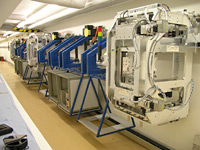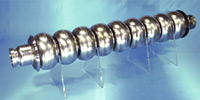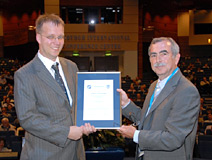 |
|
|
 |
Straighten up and fly right...

A three-car LiCAS RTRS system in the first stages of installation in DESY's 'red-green' tunnel. |
The guys from collider alignment and survey have to get it straight. If they don't the beam will go pear-shaped and it certainly won't "fly right". Emittance will go up and luminosity down – and data-taking physicists at the ILC experiments won't be happy about that. So the LiCAS team – Linear Collider Alignment and Survey – rolled up their sleeves after rolling up their technical drawings and are setting up a test system in an unused tunnel section between DESY's Doris and DESY rings. They will be testing their equipment there for a year and then hope to use an improved version on the XFEL that will start running in 2013 and also on Cornell's planned CESR-TF damping ring test facility. Ultimately the lessons learned from all this will make sure that the ILC will be as straight as can be – with the notable exception of the damping rings of course - with no more than 200 microns vertical offsets over 600 m of machine.
"I think this is a good deal better than any large scale survey to date," says Oxford university's Armin Reichold. The team from Oxford and DESY's surveyors therefore joined forces and found a solution that looks very promising. "We measure the position of the modules with the help of a large network of reference coordinates. Every 4.5 metres in the tunnel wall opposite to the machine there are retro-reflectors that form this coordinate network," explains Reichold. "What you see on the wall here at DESY is an R&D prototype of our ILC survey system. Its named RTRS for Rapid Tunnel Reference Surveyor, and travels automatically along a rail on that wall."
Each one of its finally six measurement cars will be stopped closely in front of one such marker and measure the maker's co-ordinates by multilateration, using six distance measurements – each performed by one Frequency Scanning Interferometer (FSI). The cars measure their position relative to each other using a laser straightness monitor (LSM). The LSM sends its laser beam through a vacuum tube which connects all cars together. This avoids the refraction effects that would make the measurement in open air impossible. At the end of the tube the beam is reflected back onto itself to pass once more through all cars. The vacuum same tube also houses five other sets of six FSIs which measure the distance between cars. The trio of instruments in each car is completed by a high-precision tilt sensor which levels the car in front of each wall marker.
Read more...
-- Barbara Warmbein |
 |
|
|
 |
Upcoming meetings, conferences, workshops
Vancouver Linear Collider Workshop
Vancouver, Canada
19-22 July 2006
ILC GDE Meeting
Vancouver, Canada
19-22 July 2006
2006 Linear Accelerator Conference
Knoxville, Tennessee, USA
21-25 August 2006
Linear Collider Physics School 2006
Ambleside, UK
14-19 September 2006
TTC Meeting (Tesla Technology Collaboration)
KEK
25-28 September 2006
9th International Workshop on Accelerator Alignment
Stanford Linear Accelerator Center
25-29 September 2006
Single Crystal Niobium Technology Workshop (pdf)
Araxá mine in Brazil
30 October - 1 November 2006
Request Information (email)
ILC-ECFA Valencia Workshop
Valencia, Spain
6-10 November 2006
ILC GDE Meeting
Valencia, Spain
6-10 November 2006
Annual WILGA Conference
Warsaw University of Technology Resort, Poland
21-27 May 2007
View Full Calendar...
GDE Meetings Calendar
|
|
 |
 |
|
|
 |
ILC detectors in the making

François Richard |
The experiments will be the centre piece of the future ILC. The detectors will not only physically sit right in the middle of the machine - all the physics will revolve around them as well. Sub-detector R&D and test-beam studies are aimed today at developing these experiments. Within the Worldwide Study, physicists are imagining and studying complete ILC detectors. They are designing detector concepts for the ILC. Presently, the concept teams' membership overlaps the sub-detector R&D collaborations. In a few years, competitive detector collaborations will be formed. By then, the detector concepts will have evolved into mature ILC detectors which can be built.

Jim Brau |
The main goal of developing these concepts now is to begin to work through details of detector integration, to evaluate the physics performance of an integrated system of all the detector subsystems, and to enable an evaluation of the cost of a complete detector. By combining the many elements such as tracking, calorimetry and magnetic fields, into an achievable working detector design, it is possible to reach the required feasibility, performance and cost evaluations. Many of the international collaborations for sub-detector R&D presently work independently of the concepts, and are contributing to more than one concept.

Hitoshi Yamamoto |
The ILC detector calorimeters will have to reach extreme precision on the particle jet energy measurement. Knowing this energy is crucial to understand which kinds of events were produced at one e+ e- interaction point. To solve this problem, two kinds of solutions are now being studied. Three of the four ILC detector concepts use a particle flow algorithm enabled by ultra-granular calorimeters. Such calorimeters will make it possible to reconstruct each individual particle of a given jet, including neutral particles. The newer '4th concept' uses the principle of compensation. It is aiming to read the particles energies independently of their nature (photons, electrons, hadrons…). The concepts were originally developed in specific regions: the Silicon Detector (SiD) in North America, the Global Large Detector (GLD) in Asia and the Large Detector Concept (LDC) in Europe. Now, the four concept memberships are regionally broader and physicists from around the world are contributing to all of the studies.
Read more...
-- Perrine Royole-Degieux |
 |
|
|
 |
From KEK
6 July 2006
Recommendations on Particle and Nuclear Studies at KEK
IPNS-RPC, the Research Plan Committee of the Institute for
Particle and Nuclear Studies at KEK, recently released
recommendations for future projects at KEK...
The committee submitted an original report ... in which
recommendations on possible scenarios for J-PARC,
SuperKEKB and ILC were given.
Read more... |
|
From Hamburger Abendblatt
3 July 2006
Dark Matter
Physics: Researchers from Hamburg are on the hunt for the Theory of Everything. A look into the depths of space has revealed: the Universe is different than they thought. Nobody knows why. Scientists from Hamburg want to solve the mystery...
Read more... |
|
From The Times
26 June 2006
Astronomers reach out to find Einstein's waves
ONE of the most elusive phenomena in the Universe could soon be measured for the first time after an Anglo-German team of scientists switched on a revamped detector designed to pick up gravitational waves.
Read more... |
|
|
 |
 |
|
|
 |
Demonstrating the ILC Accelerating Gradient

The ILC Niobium 9 cell 1 meter long baseline cavity. |
The central element of the ILC concept is the superconducting RF technology that will be used to accelerate electrons and positrons in the main linac. The choice of accelerating gradient is perhaps the single most important decision we have made, since it determines the length of the machine and has significant cost implications. Last December, we chose an aggressive peak gradient of 35MV/m and an operating gradient of 31.5 MV/m for our baseline. Yet, achieving this gradient in production cavities has not been demonstrated and will be a formidable challenge.
Nevertheless, we believe this gradient is a reasonable choice and establishes a realistic goal for our R&D program, especially considering what has already been achieved and what we project for TESLA-type superconducting cavities. It is also worth noting that in the longer term even higher gradients could be achieved with improved cavity shapes.
It is not an overstatement to say that our highest priority R&D goals during the reference and technical design phases of the next few years is to demonstrate high-gradient cavity performance and to establish the procedures that will be required to reliably fabricate and process the approximately 17000 cavities for the main linac. To achieve these goals, we are in the process of creating two related special task forces: one that will focus on the shorter-term cavity demonstration goals; and another that will look at the longer-term system tests, industrialisation, etc.
Read more...
--Barry Barish
Director's Corner Archive |
 |
|
|
 |
|

At the European Particle Accelerator Conference EPAC, held in Edinburgh, Scotland, from 26 to 30 June, DESY scientist Lutz Lilje received the European Physical Society Accelerator Group's Prize for an individual in the early part of his or her career, having made a recent significant, original contribution to the accelerator field. The prize was awarded in recognition of his major role in the development and testing of high gradient superconducting RF structures, including his original contributions in the development of fast tuning systems. Lilje received a cash prize, a certificate and gave a plenary talk to the more than 1000 participants at EPAC.
|
 |
|
|
 |
| Check for job openings online at the ILC Jobs page |
|
Updated Information for the Vancouver Linear Collider Workshop
Extra Meal tickets for companions and other guests.
Read more...
|
|
ILC Communications Workshop (July 18 at 2:00pm)
The North American ILC Communications group is hosting a workshop on the afternoon of July 18 -- the day before the Vancouver Linear Collider Workshop starts.
Read more... |
|
Industrial sponsors:
There will be limited opportunities to display advertising materials from potential industrial partners of the ILC at the Vancouver Linear Collider Workshop.
Read more... |
|
ILC Related Preprints
hep-ph/0607013
3 Jul 2006
Probing space-time structure of new physics with polarized beams at the ILCprints for this week
hep-ph/0606293
29 Jun 2006
Collider Signals of Top Quark Flavor Violation from a Warped Extra Dimension
hep-ph/0606292
28 Jun 2006
Higher Curvature Effects in ADD and RS Models |
|
|

